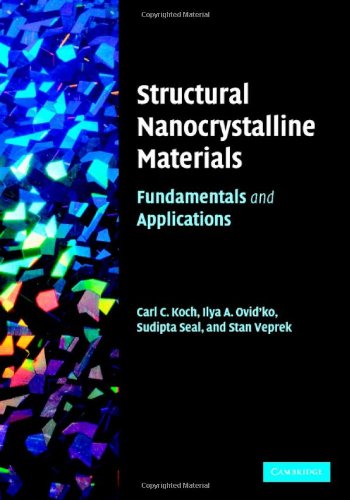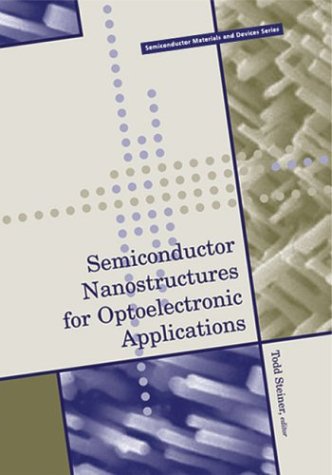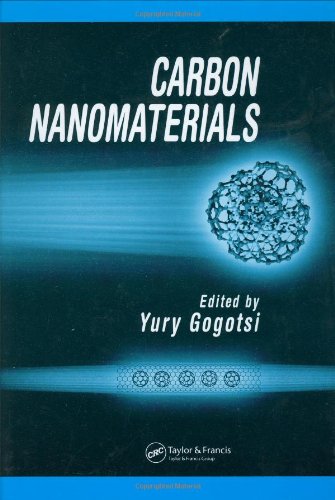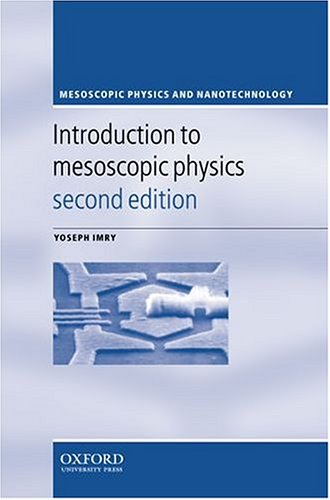Carl Koch, Ilya Ovid’ko, Sudipta Seal, Stan Veprek0521855659, 9780521855655, 9780511279300
Table of contents :
Half-title……Page 3
Title……Page 5
Copyright……Page 6
Contents……Page 7
Preface……Page 11
Acknowledgments……Page 14
1 Introduction……Page 17
1.1 Coatings and thin films……Page 18
1.2 Bulk parts……Page 21
1.3.1 Magnetic nanomaterials and composites……Page 24
1.3.3 Better insulation materials……Page 26
1.3.4 High-functional polymer nanocomposites……Page 27
1.3.5 Carbon nanotubes……Page 32
References……Page 37
2.1 Introduction……Page 41
2.2.1 Inert-gas-condensation methods……Page 43
2.2.2 Mechanical attrition methods……Page 45
2.2.3 Nanocrystalline powders by chemical reactions……Page 52
2.2.3.1 Sol–gel process……Page 53
2.2.3.2 The growth mechanism and the particle shape……Page 54
2.2.3.3 Colloidal stability of an oxide nanoparticle sol……Page 56
2.2.3.4 Selection of a polymer as a surfactant……Page 58
2.2.3.5 Microemulsion technology……Page 62
2.2.3.6 Other chemical methods for nanoparticle production……Page 74
2.2.4 Powder consolidation methods……Page 80
2.2.5 Bulk processing methods for severe plastic deformation……Page 83
2.2.6 Electrodeposition……Page 86
2.3 Preparation of nanostructured, hard, and superhard coatings……Page 88
2.3.1 Thermal CVD……Page 90
2.3.2 Low-pressure, glow discharge plasma-induced CVD……Page 92
2.3.4 Sputtering……Page 94
2.3.5 Vacuum-arc evaporation……Page 98
2.3.6 Hybrid techniques……Page 100
References……Page 101
3.1 Introduction……Page 109
3.2.1 X-ray diffraction line broadening analysis……Page 110
3.2.3 High-resolution scanning electron microscopy, SEM……Page 112
3.2.5 Raman spectroscopy……Page 113
3.2.6 Differential scanning calorimetry (DSC)……Page 114
3.3 Grain-growth theories for conventional grain size materials……Page 115
3.4 Grain growth at ambient temperature in nanocrystalline materials……Page 124
3.5.1 Kinetic approach……Page 125
3.5.2 Thermodynamic approach……Page 128
3.6 Experimental studies of isothermal grain-growth kinetics in
nanocrystalline materials……Page 130
3.7.1 Different behavior of nc-M(1)nN/M(2) and nc-MnN/a-Si3N4
and /a-BN nanocomposites……Page 134
3.7.2 Formation of strong nanostructures with high thermal stability via
thermodynamically driven phase decomposition……Page 141
References……Page 144
4.1 Elastic properties of nanostructured materials……Page 150
4.2 Anelastic properties……Page 152
4.3.1 Hardness and strength of nanocrystalline metals and alloys……Page 154
4.3.2 Hardness and strength of nanocrystalline intermetallic compounds
and ceramics……Page 161
4.3.3 Hardness and strength of multiphase nanocrystalline materials……Page 164
4.4 Ductility of nanocrystalline materials: optimization of
strength and ductility……Page 167
4.4.1 Optimization of strength and ductility in metallic materials……Page 168
4.4.2 In situ TEM and X-ray diffraction studies of nanocrystalline materials……Page 178
4.4.4 Strain rate and test temperature effects……Page 182
4.5 Superplasticity of nanocrystalline materials……Page 185
4.6 Creep of nanocrystalline materials……Page 189
4.7 Fatigue of nanocrystalline materials……Page 193
4.8 Fracture and fracture toughness of nanocrystalline materials……Page 196
4.9.1 Hardness enhancement due to energetic ion bombardment during the deposition……Page 198
4.9.2 The mechanism of hardness enhancement in heterostructures……Page 199
4.9.3.1 The role of the interfacial Si3N4 layer……Page 200
4.9.3.2 Possible mechanism of plastic deformation in superhard nanocomposites……Page 204
4.9.3.3 Hardness of the nc-MnN/a-Si3N4 nanocomposites and the role of impurities……Page 206
4.9.4 Toughness of hard and superhard nanocomposites……Page 208
4.10 Summary……Page 210
References……Page 212
5.1 Introduction……Page 220
5.2.1 Specific structural features of single-phase nanocrystalline materials……Page 224
5.2.2 Specific structural features of composite nanocrystalline materials……Page 229
5.3 Basic concepts on plastic deformation processes in
nanocrystalline materials……Page 233
5.4 Nanoscale and interface effects on lattice dislocation slip……Page 237
5.5 Deformation modes associated with enhanced diffusion along grain boundaries and their triple junctions. Competition between………Page 240
5.6 Grain-boundary sliding in nanocrystalline materials……Page 245
5.7 Interaction between deformation modes in nanocrystalline materials. Emission of lattice dislocations from grain boundaries. Twin deformation mode……Page 261
5.8 Interaction between deformation modes in nanocrystalline materials. Rotational deformation mode……Page 274
5.9 Fracture mechanisms in nanocrystalline materials. Generation, growth and convergence of nanocracks……Page 284
5.10 Strain-rate sensitivity, ductility and superplasticity of nanocrystalline materials……Page 307
5.11 Diffusion in nanocrystalline materials……Page 319
5.12 Concluding remarks……Page 322
References……Page 324
6.1 Introduction……Page 333
6.2 Effect of defects and grain size……Page 334
6.4 Nanocrystalline nickel……Page 335
6.5 Nanocrystalline cobalt and its alloys……Page 336
6.6 Zirconium and its alloys……Page 342
6.7 304 Austenitic steels: wet corrosion……Page 347
6.8 304 Austenitic steels: dry corrosion……Page 349
6.9 Magnetic nanocomposites……Page 352
References……Page 354
7.1 Introduction……Page 357
7.3 Bulk nanoribbons can tie up photonic circuits……Page 359
7.5 Nanotechnology in automotive applications……Page 360
7.6 Nanoclay–polymer composites for structural applications……Page 362
7.7 Nanotechnology in the consumer world……Page 363
7.9 Nanosteel for high wear, toughness and hardness applications……Page 366
7.10 Copper–carbon nanotube composite for high heat applications……Page 367
7.12 Application of ferrofluids with magnetic nanoparticles……Page 368
7.13 Industrial applications of nanocomposite coatings……Page 371
7.14 Applications of electrodeposited nanostructures……Page 374
7.15 Potential military applications……Page 375
References……Page 376
Index……Page 378








Reviews
There are no reviews yet.